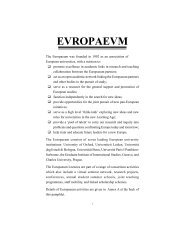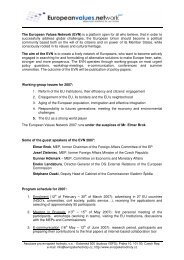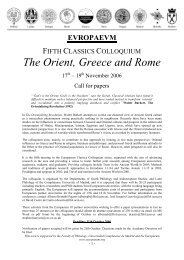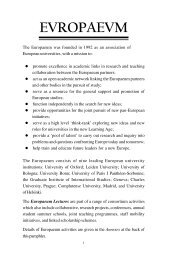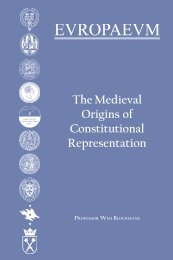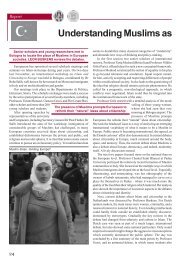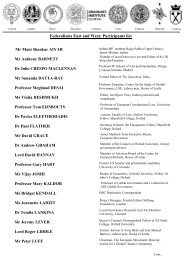Authors Iain Begg | Gabriel Glöckler | Anke Hassel ... - The Europaeum
Authors Iain Begg | Gabriel Glöckler | Anke Hassel ... - The Europaeum
Authors Iain Begg | Gabriel Glöckler | Anke Hassel ... - The Europaeum
You also want an ePaper? Increase the reach of your titles
YUMPU automatically turns print PDFs into web optimized ePapers that Google loves.
een unable to accommodate monetary policy with its fiscal stance, and to<br />
fulfill a role which makes structural reforms easier. 2<br />
Basically, the solutions that have been proposed aim in the direction of<br />
including growth and employment within the objectives of the EU (and<br />
perhaps within the statutes of the ECB), and maintaining price stability,<br />
similar to the Federal Reserve in the US. <strong>The</strong>re have also been some<br />
proposals to modify the method of selection of the Executive Board of the<br />
ECB as a result of the growing nationalisation to which the bank is being<br />
subjected. 3 Some authors have also defended the possibility of establishing<br />
an institutionalised mechanism for dialogue between the economic<br />
ministers of the EU (that meet in the Ecofin) and the ECB, so that they can<br />
agree every three years on the ideal inflation objective for the euro zone. 4<br />
Fiscal fortitude: creating good governance<br />
This is the area where most scholars have expressed criticism in recent<br />
years. In some cases, the immediate implication of this criticism was that<br />
the monetary union would never work perfectly without a fiscal union. To<br />
fully understand these arguments, it is necessary to take a brief look at the<br />
original design of the fiscal policy pillar in the EMU.<br />
<strong>The</strong> negotiations which led to the Maastricht Treaty were dominated by<br />
the alternative visions of France and Germany regarding the role that<br />
fiscal policy should play in the monetary union. While France defended<br />
the creation of an “economic government” that would ensure the “essential”<br />
coordination of fiscal policies within the EMU, Germany put its emphasis<br />
on maintaining price stability through strong mechanisms of fiscal<br />
discipline. In fact, both positions were included in the Delors Report<br />
(1989) that stressed both the need to determine in a coordinated manner<br />
the fiscal stance of the EMU, and the need to limit the size of budget<br />
deficits. Finally, both requirements became the base of the two pillars (the<br />
pillar of coordination and the pillar of fiscal discipline) of the Maastricht<br />
Treaty signed in December 1991.<br />
Nevertheless, it is worth noting that the legal force of the pillar of fiscal<br />
coordination was much weaker than the legal force of the fiscal discipline<br />
pillar. 5 While article 104 of the Maastricht Treaty included a specific<br />
objective (the limit of 3%) and detailed a concrete procedure for sanctions<br />
for infringement (later reinforced by secondary legislature contained in the<br />
SGP), article 99 reduced the strength of the pillar of coordination by means<br />
of a general proposition. 6 Later, the creation of the Eurogroup in 1997 (only<br />
as an informal forum for discussion and under the Ecofin) to compensate<br />
Chapter 5 – Carlos Mulas-Granados 79




